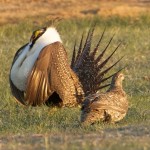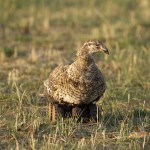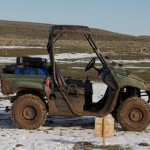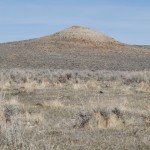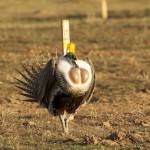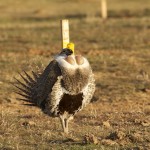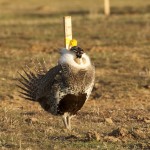We’ve now started the experimental introductions of the fembot on our three focal leks. We were definitely a bit nervous- how would the male sage-grouse react to her? Would they court her? Thankfully the answer is that they like her a lot!
We start by playing back the repeated quacking call of a real female flying onto the lek, to help add to the illusion that our animated model provides. Then the robot moves out onto the lek, and approaches a nearby male (our blinds are usually about 20m from the closest birds). We’ve managed to keep their interest long enough to test 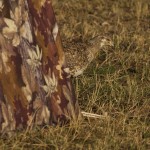 subsequent males in the area as well. Testing several males during a trial is definitely important for us- we need to achieve a sample size large enough to find statistical patterns in the midst of the considerable variation among males and trials we are likely to find.
subsequent males in the area as well. Testing several males during a trial is definitely important for us- we need to achieve a sample size large enough to find statistical patterns in the midst of the considerable variation among males and trials we are likely to find.
The experiments have not been without their excitement. The most dramatic occurrence has been getting too close to an overly eager male. Most males are perfect gentlegrouse (at least with the females), but every so often we encounter one that doesn’t seem to wait for positive signals from the female. This happened on Chugwater- a male attempted to mount the fembot before Gail could avoid him. She miraculously kept the fembot upright enough to escape, and we continued with the experiment. When approaching another male later, we got too close to this same male again, and he ended the experiment.
We are also still discovering a few mechanical issues with how the robot moves. Fortunately nothing that has compromised an experiment; these problems have only popped on the way back to the blind. On Cottontail, the robot had to come back in reverse when her motors lost forward power!
All in all, it has been a good few days! Definitely a relief that the fembot is popular. Sometimes scientific research has to be a little risky if it is going to tell us something new about the world, but it can be scary to invest so much time in something that may not yield any results. Now that we know she works, we’ll be doing experiments whenever we can until the end of the season, and hopefully learn more about the principles governing how males and females negotiate on the lek.

